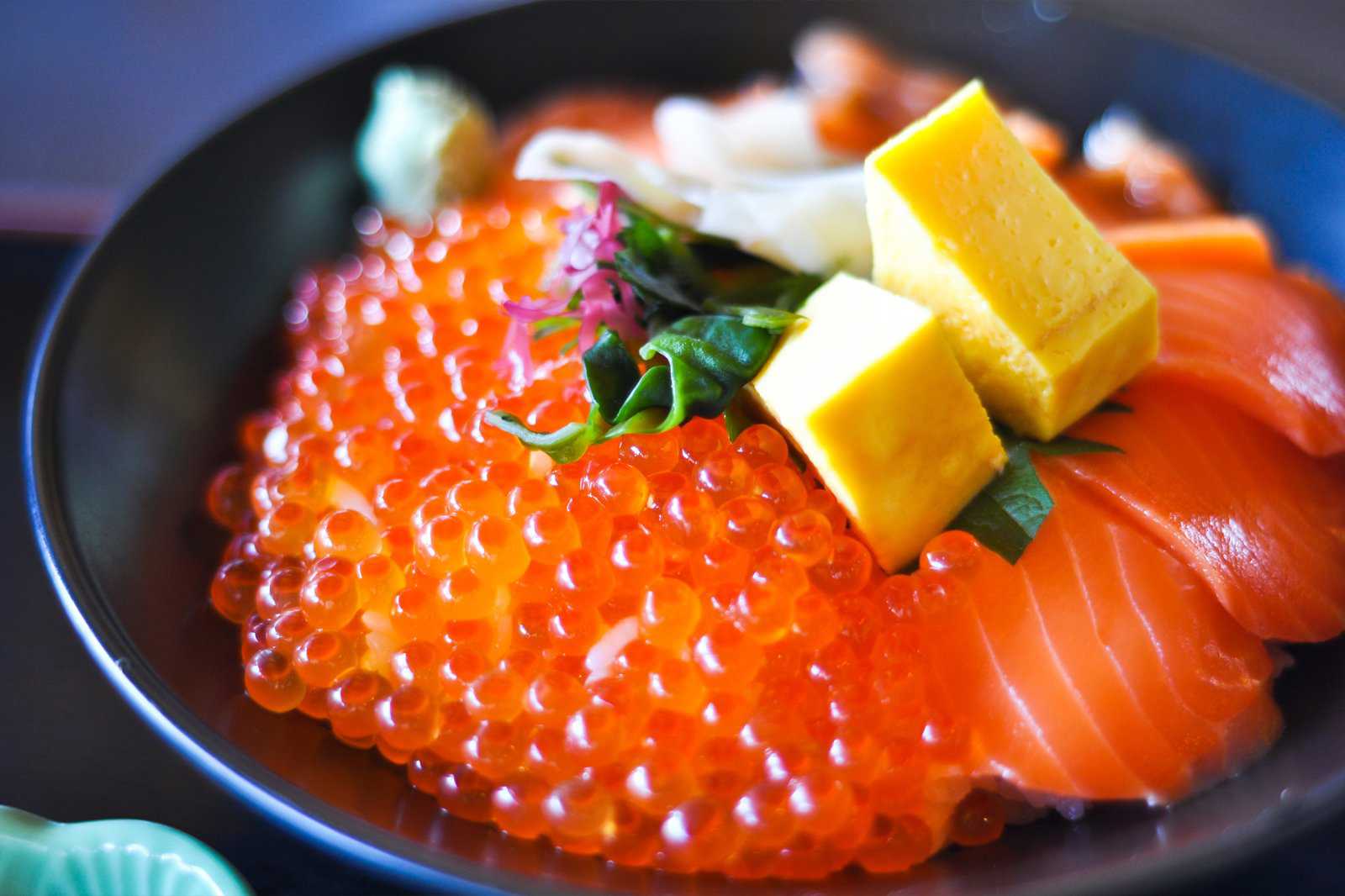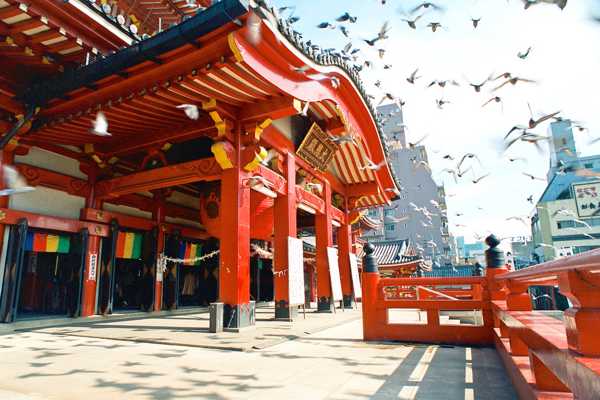Japanese cuisine is sublime in its intricacy of flavour, its variety of seasonal dishes, and its surprising health benefits. A typical Japanese meal is based on combining staples; rice or noodles are almost always served with soup, pickles and at least one okazu side dish of fish, meat vegetable or tofu.
Being an island nation, the Japanese diet is heavily influenced by seafood and offers great variety through the use of seasonal ingredients. Always artfully presented, a product of centuries of history, Japanese cuisine is a feast for the eyes as well as the stomach. Take a look at these typical Japanese dining options to get the belly rumbling. Itadakimasu!
- 1
Tempura

- Food
Crispy, tasty, somewhat healthy and cheap, tempura is one of the most popular dishes in Japan. Your choice of prawns, fish, squid, vegetables or tofu are lightly battered and quickly deep-fried to prevent the loss of nutritious vitamins and minerals. Tempura may be served on its own, but is often presented on top of noodles or rice, with a variety of dipping sauces.
- 2
Noodles: soba, udon and ramen

- Food
Noodles are a delicious and cheap alternative to a rice-based meal. Made from buckwheat flour, soba noodles have a greyish colour and are served hot with broth or cold with a dipping sauce. Udon are thick wheat noodles that are served hot or cold with soy or fish soup.
With more than 10,000 specialty shops around the country, Ramen is perhaps the cheapest and most popular type of noodle in Japan (although originally from China). Available in thin or thick varieties, ramen is most often served with a hot broth made from fish, pork, miso or soy and is topped with tempura, crumbed pork fillet, or slices of meat.
Many noodle shops operate a vending machine system. Simply buy a ticket at the vending machine when you enter. Choose your noodle preference; hot or cold, thick or thin, choose the serving size and your preferred topping. Hand the receipt to the chef or staff who will prepare it on the spot. Find a place to sit or stand and enjoy slurping your noodles along with everyone else.
- 3
Sushi

- Food
Japan’s most internationally famous dish, sushi is also internationally misunderstood. Most people are mistaken in believing that sushi is simply raw fish. Rather, good sushi is a vigilant combination of vinegared rice, raw fish and vegetables and comes in many different forms.
Sushi nigiri is the most well-known variety with a slice of raw fish or egg or vegetable perched atop a small bundle of rice. Maki sushi is the variety that is rolled in ‘nori’ seaweed. Temaki sushi is cone-shaped and full of assorted ingredients. Inari sushi features deep-fried tofu wrapped around the rice. Among the thousands of sushi shops in Tokyo alone you are sure to find a variety that suits you.
- 4
Okonomiyaki

- Food
Okonomiyaki is a fun, interactive way of dining, perfect for groups. Basically, okonomiyaki is a batter that is mixed with all your favourite ingredients then fried like a pancake on the grill right in front of you. Okonomiyaki translates as ‘grill your favourite’ and as such there is great variety in terms of ingredients available – from seafood, beef, chicken and bacon, to tofu, cheese, corn, onion and other vegetables.
Once the batter has cooked, the okonomiyaki is topped with a rich brown sauce, mayonnaise and dried bonito flakes. Typically each person in the group orders their own okonomiyaki preference and many restaurants allow you to cook your own, which is a fun addition to the meal.
- 5
Teppanyaki

- Food
Teppanyaki brings entertainment to the dinner table. You're seated around the chef and his large grill plate and watch the chef skillfully prepare your food right in front of you. This theatrical demonstration of the chef's culinary skills is part of the beauty of teppan. In many of the larger hotels the teppan chefs actually perform amazing stunts, juggling with their razor-sharp knives, catching tiny morsels with chopsticks and generally wowing their audience of diners.
Teppan menus are typically course-based with some kind of beef, ranging from the extremely popular and expensive Kobe beef to lesser grades. Vegetables, rice and pickles are also usually included.
- 6
Teishoku - a set meal

- Food
Set meals are very popular, particularly at lunch time, and most restaurants offer set meals of some kind. Typically, a set meal includes rice, pickles, soup and a main dish of fish, seafood, vegetables or meat. With lots of food and cheap prices the teishoku dining option is a great introduction to everyday Japanese food.
Some of the better restaurants offer kaiseki – a traditional Japanese tasting menu. The preparation of kaiseki is considered an art form requiring a careful balance of taste, texture, appearance and colour, using only fresh seasonal ingredients. Expect exquisite presentation, and higher than average prices.
- 7
Yakiniku

- Food
This is another fun, interactive way of eating in Japan. Yakiniku hails from Korea and is essentially a do-it-yourself barbecue with bite-sized pieces of beef, pork and vegetables that you cook on the grill in front of you. The thin slices of meat and vegetable cook quickly and are then doused into a soy-based dipping sauce flavoured with sesame, garlic and sake.
Menus usually offer plates of different ingredients and a table may order two or three different plates and spend hours slowly cooking and eating. Rice and pickles usually accompany the meal.
- 8
Yakitori

- Food
The Japanese believe yakitori is the perfect accompaniment to beer, and in the late hours of the night yakitori stands are always full of life. Yakitori translates as grilled chicken and some restaurants serve up to 20 varieties of the skewers, each a different part of the chicken, including breast meat, wings, heart, parson’s nose, and skin. Your yakitori can be flavoured with shio (salt), or tare (a sweet-salty sauce). Yakitori is a very popular and cheap snack food, usually only 100-200 yen per skewer.
- 9
Shabu Shabu and Sukiyaki

- Food
Shabu shabu is another fun dining option for groups and families. After ordering plates of thinly sliced meat and vegetables, a pot filled with boiling soup is placed on the table. Using chopsticks each diner picks up a slice of meat
and swishes it around in the soup until it cooks. The meat is then dipped into a salty shabu shabu sauce and enjoyed before swishing the next piece. Predominately beef based, shabu shabu can also include seafood and pork.
Similarly, sukiyaki presents meat, seafood and vegetables in a sweet-salty soy-based soup. The difference is that ingredients bubble away in the pot continuously and diners fish out the slices they want, perhaps dip it in raw egg, and enjoy.
- 10
Fugu (blowfish)

- Food
The seas surrounding Japan are home to several hundred types of blowfish and it’s believed the Japanese have been eating the poisonous fish for as long as 15,000 years.
Be sure to try fugu while you are in Japan – if not for its delicate taste, then for bragging rights – and then only from a licensed expert. Chefs must train for many years to learn how to prepare these potentially dangerous sea creatures. Once prepared, fugu can be eaten in a number of ways, including fresh slices of sashimi. boiled in a hot pot or grilled with vegetables.
photo by Peter Kaminski (CC BY 2.0) modified
- 11
Unagi (eel)

- Food
Unagi is a hearty, nutritious meal loaded with vitamins and protein that's very popular in Japan. Usually served with a sweet soy teriyaki sauce over rice, the Japanese believe that eating eel during the hottest months helps fight fatigue.
There are delicious unagi restaurants all over the country particularly in the Hamanako area which has a whole culture based around the slippery fish.







![[Renewal]Quadruple Room- Ground Floor (Cleaning is Optional with Additional Cost), 7 Adults](https://images.trvl-media.com/lodging/9000000/8490000/8486500/8486490/0236c098.jpg?impolicy=fcrop&w=357&h=201&p=1&q=medium)











